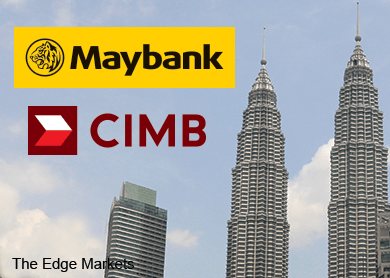
This article first appeared in The Edge Malaysia Weekly, on November 2 - 8, 2015.
Analysts are not convinced that CIMB Group Holdings Bhd’s and Malayan Banking Bhd’s (Maybank) Indonesian banks — PT Bank CIMB Niaga Tbk and PT Bank Maybank Tbk, respectively — are out of the woods yet, going by their third-quarter numbers released last week.
“I’m still wary about bad loans rising. I don’t think they’re out of the woods yet. With the continued headwinds in the sector — other banks there are seeing an uptick in nonperforming loans (NPL) — it’ll be hard for them to run too far from the broader environment,” says one Kuala Lumpur-based banking analyst.
CIMB Niaga, the fifth largest bank by assets, last Friday turned in a business-as-usual (BAU) net profit of IDR442 billion for the quarter ended Sept 30, 2015 (3QFY2015) — an improvement from IDR343 billion in the same quarter a year ago and IDR93 billion in 2QFY2015. The BAU net profit excludes an exceptional expense of IDR471 billion from its mutual separation scheme in 3QFY2015.
Actual net profit for the quarter came in at IDR89 billion, 72.9% lower year on year and 4.3% lower quarter on quarter. Provision expenses were down 10.8% q-o-q to IDR1.19 trillion.
CIMB Niaga’s asset quality improved, with the gross NPL ratio coming down to 3.17% from 4.28% in 2QFY2015. But analysts point out that this was because it had sold some bad loans to a special purpose vehicle (SPV), or “bad bank”. The SPV is an affiliated company of CIMB Group (fundamental: 1.05; valuation: 1.65).
“The SPV was created at the group level, so when CIMB Group announces its results later, on a consolidated basis, the NPLs will still show,” an analyst remarks. “If the loans had not been sold to the bad bank, 1.5 percentage points would have been added to CIMB Niaga’s NPL ratio.”
The bad loans that were sold were from the troubled coal sector. “The group felt that the coal sector would take longer to restructure, so they put the bad loans in an SPV,” the analyst adds.
Analysts are also concerned about a rise in CIMB Niaga’s special mention loans, or loans overdue by up to 90 days but yet to turn bad. They accounted for 8.2% of total loans as at September 2015, compared with 6.1% in June 2015.
CIMB Niaga’s management had guided in a conference call with analysts last Friday that the bank’s provision level in the fourth quarter would remain elevated, though likely lower than that in 3QFY2015. “It shows that the situation in Indonesia is still fluid,” one of the analysts remarks.
CIMB Niaga’s net interest margin (NIM) in the third quarter improved to 5.4% from 5.04% in the preceding quarter, but the margin is expected to remain under pressure.
For the cumulative nine months, its BAU net profit stood at IDR618 billion, a 73.1% decline from the same period a year ago. Loan growth was 7.2%.
CIMB Niaga president director Tigor M Siahaan is cautiously optimistic about the group’s business direction going forward. “We continued to grow our assets selectively [in the nine months] and are closely monitoring asset quality. We see opportunities and will place added focus on the consumer and small and medium enterprise segments in a bid to improve our performance and boost earnings growth. We are conservative in this environment and have increased loan loss coverage to 120.96% [from 82.89% in September 2014] to ensure adequate reserves,” he says in a press release.
Analysts keep a close watch on CIMB Niaga’s performance as it accounts for a substantial portion of CIMB Group’s earnings. Last year, it accounted for just 19% of CIMB Group’s earnings, but in previous years, it used to be about 30%. It has become a key sticking point in CIMB Group’s growth outlook.
In comparison, Maybank Indonesia — formerly known as Bank Internasional Indonesia — accounts for only about 5% of Maybank’s (fundamental: 1.40; valuation: 2.25) earnings
Maybank Indonesia, the eighth largest lender, last Thursday announced a third-quarter net profit of IDR204 billion — a sharp improvement from the IDR6 billion it made in 3QFY2014 and the IDR133 billion it made in 2QFY2015.
For the cumulative nine months, net profit came in at IDR592 billion, a 70.7% increase from the same period a year ago. It attributed the better performance to improved net interest income, NIM, fee-based income, growth in deposits and shariah banking. Loan growth stood at 6.6%. Its shariah banking net profit rose almost six times to IDR239 billion in the nine months. NIM improved to 4.82% from 4.63%.
However, Maybank Indonesia’s asset quality deteriorated as businesses were affected by the economic slowdown and weakening currency. Its consolidated gross NPL ratio rose sharply to 4.21% as at Sept 30, from 2.55% a year ago.
“The bank continued to manage down exposures from certain corporate accounts that had led to an increase in NPL level. The bank has actively carried out restructuring of those accounts and expects to see improvements in the coming months,” it says in a press release.
Most Indonesian lenders have seen a deterioration in asset quality in recent quarters as the economy slows, hurt by a collapse in commodity prices and a weaker rupiah. Second-quarter GDP grew 4.67%, its slowest pace in six years.
Last week, PT Bank Mandiri Tbk, the largest lender, reported a 3% drop in third-quarter net profit to IDR4.65 trillion on a q-o-q basis. Its gross NPL ratio rose to 2.8% from 2.4% in the preceding quarter. PT Bank Danamon Indonesia Tbk, the sixth largest, saw gross NPL ratio rise to 3% from 2.8% over the same period.
Save by subscribing to us for your print and/or digital copy.
P/S: The Edge is also available on Apple's AppStore and Androids' Google Play.